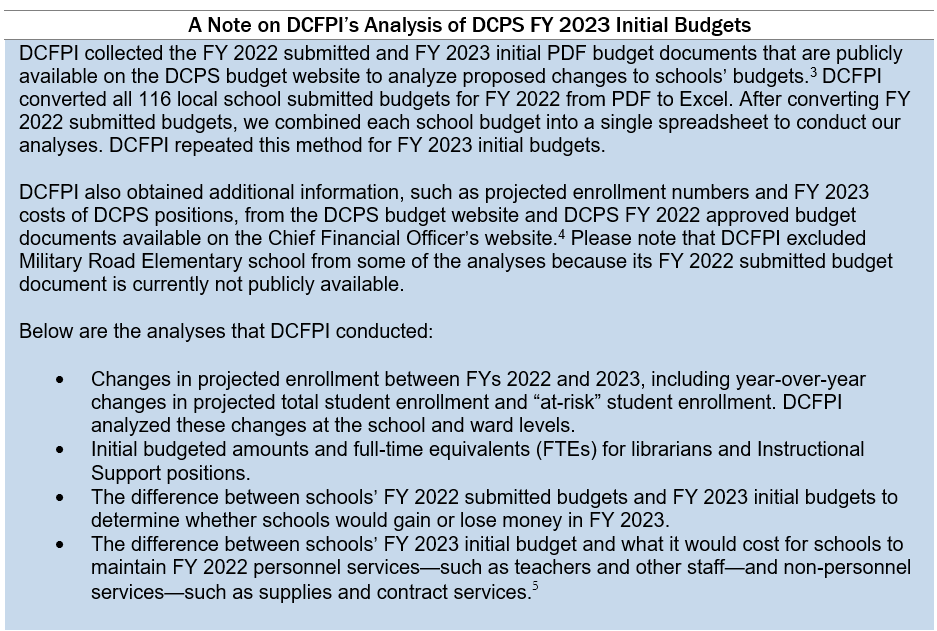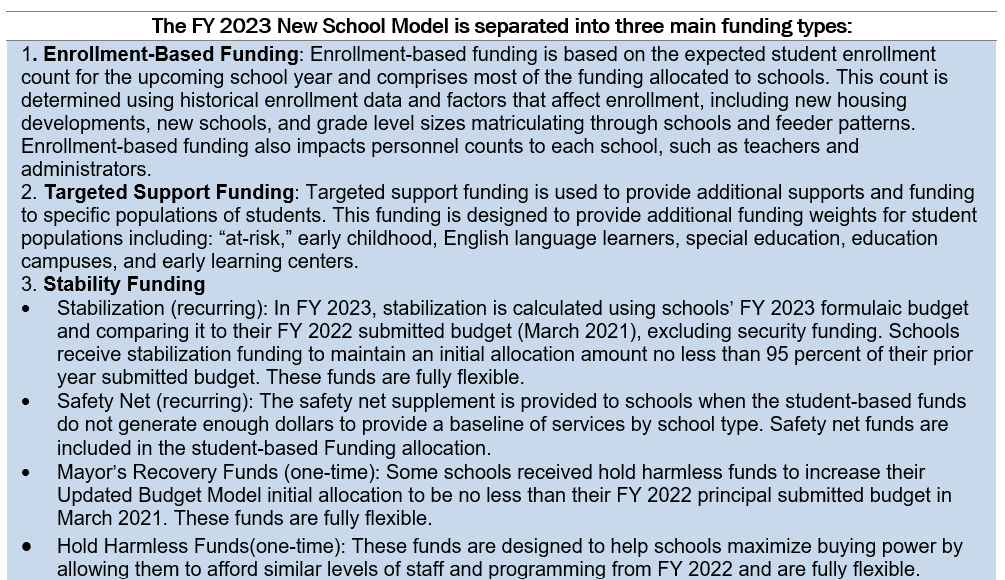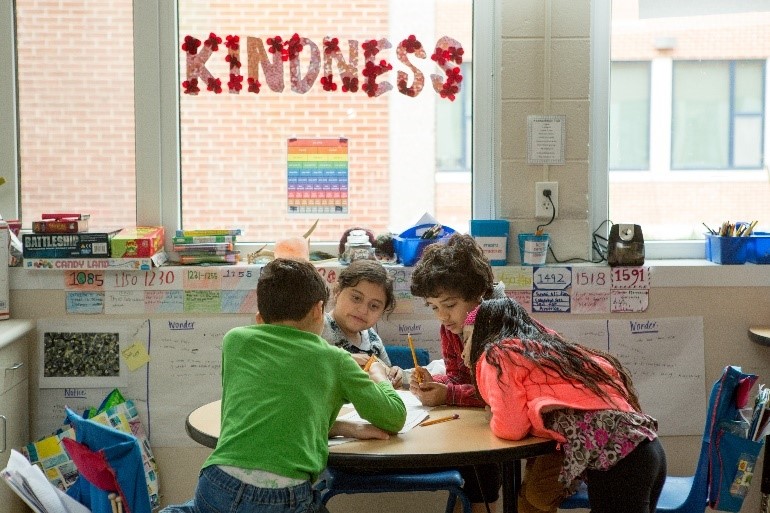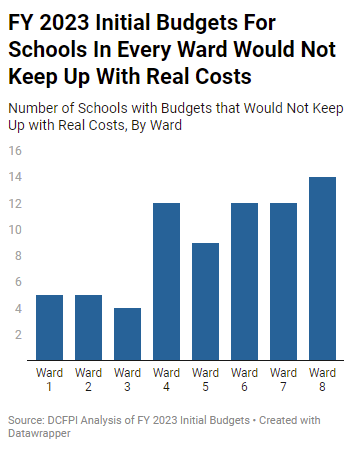
More than half of the schools within DC Public Schools (DCPS) have fiscal year (FY) 2023 initial budgets that are lower than their FY 2022 budgets that were boosted by federal funds. Additionally, 73 schools have initial FY 2023 budgets that would not keep up with real costs based on DCFPI’s analysis, if approved by lawmakers as-is.[1] Schools projected to experience enrollment declines—most of which are concentrated in Wards 4, 7, and 8 and serve a disproportionate share of Black and Latinx students and students from families with low incomes—are most at risk of potential budget cuts in FY 2023.
For FY 2023, the Mayor has proposed a 5.9 percent increase (not inflation adjusted) to the per-pupil base of the Uniform Per Student Funding Formula (UPSFF) and a suite of funds to stabilize school budgets that would otherwise decrease significantly due to enrollment declines. In addition, DCPS has launched a new school budget model. These are welcome changes and reflect the strides that the District has made to invest more deeply in public education. Importantly, DCPS’ new budget model takes steps to improve transparency and give schools more control over how they invest their dollars. For example, DCPS is giving schools discretion over how they spend their “at-risk” funds, which are additional dollars that schools are legally entitled to receive to meet the needs of students from families with low incomes, who are mostly Black and brown in DC. Yet these changes alone may not be enough to stabilize schools’ budgets or usher in long overdue structural changes that build towards an equitable and antiracist future for all DC students.
In FY 2022, many schools are relying on one-time Elementary and Secondary School Emergency Relief (ESSER) Funds to cover costs of classroom teachers, aides, and other key general education positions. Consequently, schools are facing potential “fiscal cliffs” where one-time federal dollars used to fund recurring expenses will disappear. The District is missing an opportunity to leverage its growing revenue to adequately increase local spending on general education services. This would allow schools to not only use their ESSER funds to make deeper investments in educational resources but would also allow schools to spend “at-risk” and other targeted funds on additional resources for students furthest from opportunity.
Policymakers can and should keep and build on the promises they made to meet the educational and socio-emotional needs of students— one of several sound steps for sustaining an equitable recovery from the pandemic.[2] To do this, DCFPI recommends that the Mayor, DC Council, and top education officials:
- Ensure that schools have enough local, recurring dollars to cover rising costs in FY 2023.
- Transparently provide additional ESSER funds to allow schools to invest in targeted resources that help boost the academic outcomes of Black and brown students and students from families with low incomes.
- Ensure that schools do not lose staff positions in a manner that is disproportionate to grade level projected enrollment declines.
- Add a small school supplemental weight to DCPS’ new budgeting model to ensure that schools with declining enrollment can afford general education services without having to supplant “at-risk” funds.
- Create and enforce a District-wide education vision that protects enrollment in neighborhood schools in all eight wards.

How DCPS’ New Budget Model Differs from the Comprehensive Staffing Model
The updated DCPS budget model differs from the system’s Comprehensive Staffing Model (CSM) that has been in place for more than decade. The CSM is a staff-based allocation model, where DCPS allocated staffing and non-personnel services to schools based on enrollment and school level. This model did not allocate funding on a per-pupil basis. The new budget model is a student-based budgeting model that allocates dollars to schools based on the number of enrolled students, where students are funded through a base weight and additional supplemental weights based on student need. The model designates three types of funding (enrollment based, targeted support, and stability funding), gives principals and Local School Advisory Teams (LSAT) more discretion over spending decisions, and changes which positions are required versus flexible.[6],[7] Within stability funding, the new budget model also offers four different sub-categories of resources, all of which principals and LSATs have full discretion over how they invest: safety net, stabilization funding, recovery funding, and hold harmless funding.

Funding requirements for certain staffing positions have also changed under the new school model. Funding for position levels range from required (L1) to fully discretionary (L3), with L3 granting principals and LSATs the most flexibility. Schools are not allowed to reallocate positions of funding for required items or positions. L2 funding for positions grants schools slightly more discretion and L3 funding for positions are completely discretionary, meaning funding originally allocated for these positions can be re-allocated to support other programming and staffing costs as needed.
In FY 2023, DCPS is proposing to spend $13.5 million to make librarians a required position following years of local advocacy to ensure every school has a full-time librarian. DCPS reclassified many other positions down from L1 to L2 to allow schools greater flexibility over these dollars, including English learner (EL) teachers and aides, special education aides, early childhood teachers and aides, psychologists, social workers, and others.
Notably, DCPS is no longer pre-budgeting key general education positions such as regular classroom teachers and music and arts teachers, attendance counselors, assistant principals, and others. Ideally, schools will be able to cover staffing costs by primarily using their enrollment based and stability funds, leaving their targeted support funds as extra resources that boost the academic achievement of students furthest from opportunity. Because these positions are no longer pre-budgeted, schools will use their enrollment based, targeted supports, and stability funding to cover a mix of positions, as desired and their allotment allows.
While DCPS increases flexibility around staffing—a positive change—it decreases public visibility into whether schools have enough funding to cover all their staffing needs. For example, because general education teachers are no longer allocated with FY 2023 initial DCPS budgets, it is impossible to determine how many general education teachers will be budgeted in FY 2023 until schools submit their final budgets. DCPS should release schools’ FY 2023 submitted budgets as soon as possible to give a more complete picture of schools’ budgets.
DCPS Changed How it Allocates “At-Risk” Funds, Added Two Additional Weights to Target Even More Funds

With its new school budget model, DCPS has made significant changes to how it allocates the “at-risk” funding it receives through the UPSFF to schools.[8] DCPS will allocate its “at-risk” dollars in the form of a program grant, giving principals and LSATs more discretion over how they invest their “at-risk” funds. Based on DCFPI’s analysis, DCPS would provide $2,683 per “at-risk” student via the grant program in FY 2023, although almost all the high schools would receive slightly higher “at-risk” per pupil amounts.[9] In total, DCPS would invest $63.3 million in “at-risk” program grants.
In addition, DCPS’ new model provides additional “at-risk” funding outside of the “at-risk” grant via two new weights that are part of the student-based budgeting part of its new funding model. With these additional weights, DCPS aims to drive more dollars to schools where poverty and other barriers to learning are more concentrated among their student populations. Schools with 40 and 70 percent or more “at-risk” student populations—many of which are racially and socioeconomically segregated—will benefit from this new policy.[10] Under the FY 2023 initial budgets, DCPS would invest $9.8 million in “at-risk” concentration weight funding, bringing DCPS’ total FY 2023 “at-risk” funding to a total of $73.1 million. If the Mayor or Council do not make any changes, this would be a 6.7 percent increase over how much DCPS allocated in total for “at-risk” in FY 2022, adjusted for inflation.
DCPS’ decision to switch to a grant allocation model appears to be in direct response to advocates’ calls for more transparency and advocates’ demand that DCPS stop using “at-risk” funds to cover general education expenses, which is a direct violation of the DC law that requires the system layer “at-risk” funds on top of school budgets.[11]
The changes that DCPS is making to “at-risk” funding under its new school budget model are welcome. The public is now more clearly able to see how “at-risk” funding DCPS is directly invested in schools. Still, these changes alone may not reduce schools’ need to use “at-risk” funds to cover basic general education services, such as a principal, teachers, social workers, supplies, and other materials. Ideally, schools could cover their general education services with their enrollment-based funding, leaving them able to truly target additional resources to students who face the largest barriers to academic success via dollars from their targeted support funding allocation. However, given the fact that DCPS has given schools complete discretion over how they can allocate their “at-risk” dollars, DCFPI is unable to determine the extent to which schools would need to use “at-risk” and other targeted funds to cover general education costs based on data that is available at this time.
Enrollment Continues to Suffer at Elementary Schools and Schools East of the River
Overall, DCPS is projected to lose nearly 1,000 students in FY 2023, bringing the sector’s enrollment to 50,445 students. This represents a 2 percent decline over the system’s projected FY 2022 enrollment and follows a decade of consistent enrollment gains further disrupted by the pandemic. The Deputy Mayor for Education (DME), who projects public school student enrollment in the city, expects DCPS to see the largest enrollment declines in the earliest grades, which is consistent with enrollment trends nationwide.[12] The DME projects that elementary schools will lose more than 1,000 students between FYs 2022 and 2023 (Table 1). Alternatively, the DME projects high school enrollment to grow with DCPS adding nearly 600 students—an increase of almost 6 percent over FY 2022.

Across wards, the DME projects enrollment to decline in every ward except Ward 5 (Table 2). These trends in enrollment reflect the ongoing challenges that the pandemic poses for many families. Some parents have opted to homeschool their children, some have utilized DC’s expansive charter and private school network and transitioned their students out of the traditional DCPS system, and some have moved out of the District entirely. [13]

The DME projects that schools in Wards 7 and 8—DC’s Blackest and lowest income communities—will experience the largest enrollment declines. As enrollment is the main factor that drives a school’s budget, these declines could undermine the very schools that already struggle to meet the needs of their students. While DCPS’ enrollment methodology attempts to keep schools whole amid enrollment losses, opportunities remain to protect neighborhood schools from funding losses due to student population decline.[14] For example, DCPS could explore the addition of a new weight for schools with below average enrollments, whose funding is more sensitive to enrollment fluctuations.
Another major enrollment concern is a growing saturation of new charter schools, especially in Wards 5,7, and 8, without a proportionate growth in DC’s school-age population. This can lead to more families opting out of neighborhood schools and in turn, drive down DCPS enrollment. Although DCPS has experienced enrollment declines during the pandemic, DCPS enrollment steadily climbed in the decade prior.[15] Conversely, charter school enrollment has continued to climb both before and during the pandemic—in the District and nationwide.[16] From FY 2020 to FY 2022, public charter school audited enrollment increased by 1,658 students while DCPS audited enrollment declined by 1,538 students during this same period.[17]
These enrollment trends are likely to continue as the Public Charter School Board has authority to open up to 10 new charter schools per year regardless of enrollment capacity needs.[18] Considering DCPS schools in Wards 5, 7, and 8 only have about 50 percent of enrollment capacity due to school closures, charter growth without corresponding growth in the number of students will likely attract students away from DCPS neighborhood schools in these wards that have been historically underfunded. To protect against enrollment losses within DCPS, policymakers can require new charters to consider enrollment capacity needs and place a cap on the number of charter school openings, as many other states have done.[19]
Half of DCPS Schools Face Potential Funding Gaps in FY 2023 Compared with their ESSER-Boosted Budgets of FY 2022
As proposed, 58 of the 116 schools in DCPS would have FY 2023 budgets that are lower than their submitted budgets in FY 2022, which were buoyed by federal dollars. Many schools received large sums of one-time ESSER II and III funds in their FY 2022 submitted budgets to address the fallout of the health and economic crisis. But many schools are leveraging these funds this school year to pay for what seem to be recurring expenses, such as classroom aides, science teachers, and other general education positions, signaling true staffing needs that would otherwise have gone unmet. Consequently, some schools are facing a fiscal cliff and are likely having to forgo certain resources even with DCPS providing some schools stability funds in FY 2023. DCFPI has heard anecdotally that DCPS is allowing schools to request remaining ESSER funds to make up funding gaps, but DCPS has not publicly shared this information.
Across all 58 schools, the average gap between schools’ FY 2023 initial budget and FY 2022 submitted budget is $242,193—the equivalent of two full-time teachers. While most of these schools are projected to experience enrollment declines, there are several schools for which the DME has not projected a decline and there are even a few schools that the DME has projected will gain students. Forty percent of the schools are in Wards 7 and 8 where the combination of historical and ongoing divestment in Black and low-income communities and extreme housing unaffordability fuels persistent enrollment declines in neighborhood schools East of the Anacostia River (Figure 1). Another 21 percent of the schools are in Ward 4.

Even for schools where enrollment is declining, that decline does not always result in a clear-cut change in staffing needs—other interlocking factors create complexity. For example, projected enrollment loss is often spread across grades, and relatedly, because the dollar loss in funding from enrollment declines is so great, schools can’t just trim around the edges. Instead, they are forced to cut whole positions within a specific grade level or cross-cutting roles that serve all students. Another, longer-term factor is DCPS’ ongoing failure to fund general school operations and staffing adequately and equitably. Federal relief dollars were never supposed to permanently make school budgets whole. Many schools have relied on these funds in the last two budget cycles to maintain their staffing levels from prior years and still DCPS and the Mayor missed an opportunity with the new school budget model to align local dollar investments with how much schools truly need to sustain their investments moving forward.
Three out of Five School Budgets Would Not Keep Up with Real Costs
Seventy-three schools have FY 2023 initial budgets that would not keep up with FY 2023 costs—a combination of staffing costs which DCPS itself itemizes and non-personnel services that DCFPI adjusted for inflation. Schools with budgets that would not keep up with FY 2023 costs and inflation are concentrated in Wards 4, 6, 7, and 8, although there are schools in every ward that have FY 2023 initial budgets that would not keep up (Figure 2). The average gap across the 73 schools is nearly $270,000.

In FY 2023, DCPS is budgeting a 1 percent increase in the average teacher cost, while budgeting smaller and larger increases for other positions. Non-personnel services (NPS) costs are increasing at varying rates, with one rate being as high as 10 percent. DCFPI applied a FY 2023 projected inflation rate of 2.29 percent increase for any NPS cost where DCPS did not provide information.[20]
The Mayor and DCPS assumed a 3 percent increase for NPS costs, but DCFPI did not receive information about the assumptions the Mayor and DCPS used for budgeting FY 2023 personnel services costs. Despite the NPS adjustment, two-thirds of schools’ FY 2023 initial budgets would still not allow schools to maintain the staffing levels and NPS allocations that they received in FY 2022, adjusted for real costs and inflation. This is an ongoing issue that policymakers have failed to address budget after budget. DCFPI and other advocates have repeatedly highlighted how bad budgeting practices, such as the Chief Financial Officer’s failure to prepare a Current Services Funding Level budget for DCPS and the public charters and the Mayor basing her proposed increases to the UPSFF on the District’s revenue and other local priorities instead of actual costs to operate the two systems, undermine policymakers’ ability to adequately fund school budgets.[21] Furthermore, DCPS’ own failure to fund schools adequately and equitably through its budgeting models over the years has harmed Black and brown students, families, and schools in Wards 7 and 8.[22]
Policymakers Should Adopt Multi-Layered Approach to Right-size DCPS Budgets
With its new budget model, DCPS has taken steps toward equity, transparency, and sustainability—outcomes the school system has listed as key goals of the model. However, the pandemic has further uncovered how the District’s longstanding inadequate funding of DCPS and DCPS’ inequitable funding of schools has harmed DC students, families, and educators.
With the pandemic still presenting unprecedented challenges to students, especially Black and brown students and students from families with low incomes, right-sizing DCPS budgets is essential. DCPS’ new budget model answers some questions but leaves many more unanswered. Absent DCPS sharing schools’ FY 2023 submitted budgets when the Mayor releases her budget proposal, the public can only make a best guess at how public schools would actually fare under the new budget model.
DC policymakers should embrace a combination of immediate and longer-term policies that ensures both funding adequacy and equity. DCFPI recommends that the Mayor, Council, and top education officials:
- Ensure that schools have enough local, recurring dollars to cover rising costs in FY 2023.
- Transparently provide additional ESSER funds to allow schools to invest in targeted resources that help boost the academic outcomes of Black and brown students and students from families with low incomes.
- Ensure that schools do not lose staff positions in a manner that is disproportionate to grade level projected enrollment declines.
- Add a small school supplemental weight to DCPS’ new budgeting model to ensure that schools with declining enrollment can afford general education services without having to supplant “at-risk” funds.
- Create and enforce a District-wide education vision that protects enrollment in neighborhood schools in all eight wards.
[1] DCFPI assigned FY 2023 costs to FY 2022 personnel services (PS) and non-personnel services (NPS) based on DCPS’ FY 2023 Item Catalog that is available in the Principal Budget Development Guide on DCPS’ budget website. The catalog does not provide all item costs, so analysts used the costs listed on FY 2023 initial budget documents if they were available. Any NPS costs that were not listed in the catalog or in FY 2023 initial budget documents were adjusted by an inflation rate of 2.29 percent.
[2] DC Fiscal Policy Institute, “Principles for Sustaining an Equitable Recovery,” DCFPI, February 8, 2022.
[3] DCPS, School Budget Worksheets.
[4] FY 2022 Approved Budget, DC Public Schools.
[5] To do this, analysts assigned FY 2023 costs to FY 2022 PS and NPS based on DCPS’s FY 2023 Item Catalog that is available in the Principal Budget Development Guide on DCPS’ budget website. The catalog does not provide all item costs, so analysts used the costs listed on FY 2023 initial budget documents if they were available. Any NPS costs that were not listed in the catalog or in FY 2023 initial budget documents were adjusted by an inflation rate of 2.29 percent.
[6] Funding for position flexibility levels range from Level 1(L1) to Level 3(L3) with L3 granting principals and LSATs the most discretion. Schools are not allowed to reallocate positions of funding for L1 items or positions. L2 funding or positions are slightly more flexible. Lastly, L3 funding or positions are completely flexible, and funding originally allocated for these positions can be re-allocated to support other programming and staffing costs as needed.
[7] A Local School Advisory Teams is a group of elected school and community representatives that advise principals on school priorities and influence budget decisions.
[8] The UPSFF includes an at-risk supplemental weight that is multiplied by the per-pupil base, or foundation level, to generate additional dollars that DCPS and public charter LEAs must use to provide additional supports to students who are considered at-risk of academic failure. By law, DCPS is required to allocate 90 percent of its at-risk funds to schools directly and must supplement, not supplant school budgets with at-risk dollars.
[9] Schools that would receive a higher than average at-risk per-pupil for the at-risk program grant include Anacostia High School, Ballou High School, Bard Early College, Benjamin Banneker High School, Columbia Heights Education Campus, Coolidge High School, Duke Ellington School of the Arts, Dunbar High School, Eastern High School, H.D. Woodson High School, McKinley Technology High School, Phelps High School, Ron Brown Preparatory High School, Roosevelt High School, School Without Walls High School, and Wilson High School.
[10] DCPS has not publicly shared its reasoning for implementing at-risk concentration weights at schools with 40 percent and 70 percent at-risk. However, some research shows that there can be multiple “tipping points” at which school-level poverty has a statistically negative effect on test scores.
[11] The addition of concentration weights also appears to be in response to the 2020-21 UPSFF Working Group’s recent report and legislation previously introduced by Councilmembers Trayon White and Brianne Nadeau that called for the District to invest more at-risk funds at schools with at-risk populations of 70 percent or higher.
[12] Anya Kamenetz, “Where are the students? For a second straight year, school enrollment is dropping,” NPR, December 15, 2021.
[13] Jenny Abamu, “D.C.’s Low-Income Neighborhood Schools Are Losing Money. Is The Budget Or Enrollment To Blame?,” WAMU, April 5, 2019.
[14] “Enrollment Projection Methodology,” District of Columbia Public Schools.
DCPS projects enrollment for the upcoming school year by analyzing enrollment trends over the previous 3 school years through a ‘cohort-survival method’. This allows DCPS to control for large year-over-year enrollment fluctuations at a given school. DCPS also added additional components to their funding methodology to support schools serving younger students from enrollment losses during the Covid-19 Pandemic. Across 1st to 5th grade, DCPS expanded their model to include pre-pandemic trend data from 2018 and 2019, beyond the usual past three years of data. Additionally, at schools where Kindergarten enrollment was projected to decline by 10 or more students, DCPS proactively assumed a larger enrolling Kindergarten in-boundary class would enroll next year.
[15] Master Education Finance and Data Spreadsheet, Tab: EnrollmentbyGrade, Cell D28
[16] Debby Veney and Drew Jacobs, “Voting with Their Feet,” National Alliance for Public Charter Schools, September 2021.
[17] Master Education Finance and Data Spreadsheet, Tab: EnrollmentbyGrade, Cells F30(DCPS) & E13 (PCS)
[18] “C4DC Statement on Strengthening DCPS Education,” Coalition for DC Public Schools & Communities, March 2022
[19] Perry Stein, “More charter schools want to open in D.C., but how many can the city handle?”, The Washington Post, May 2019.
[20] DCFPI Inflation Calculator. Inflation adjustment is based on CPI-U published in the most recent CBO 10-year economic projections released July 2021.
[21] Qubilah Huddleston, “Raising the Bar: Budgeting for a Strong Public Education System,” DCFPI, December 17, 2019.
[22] Jenny Abamu, “D.C.’s Low-Income Neighborhood Schools Are Losing Money. Is The Budget Or Enrollment To Blame?,” WAMU, April 5, 2019.
